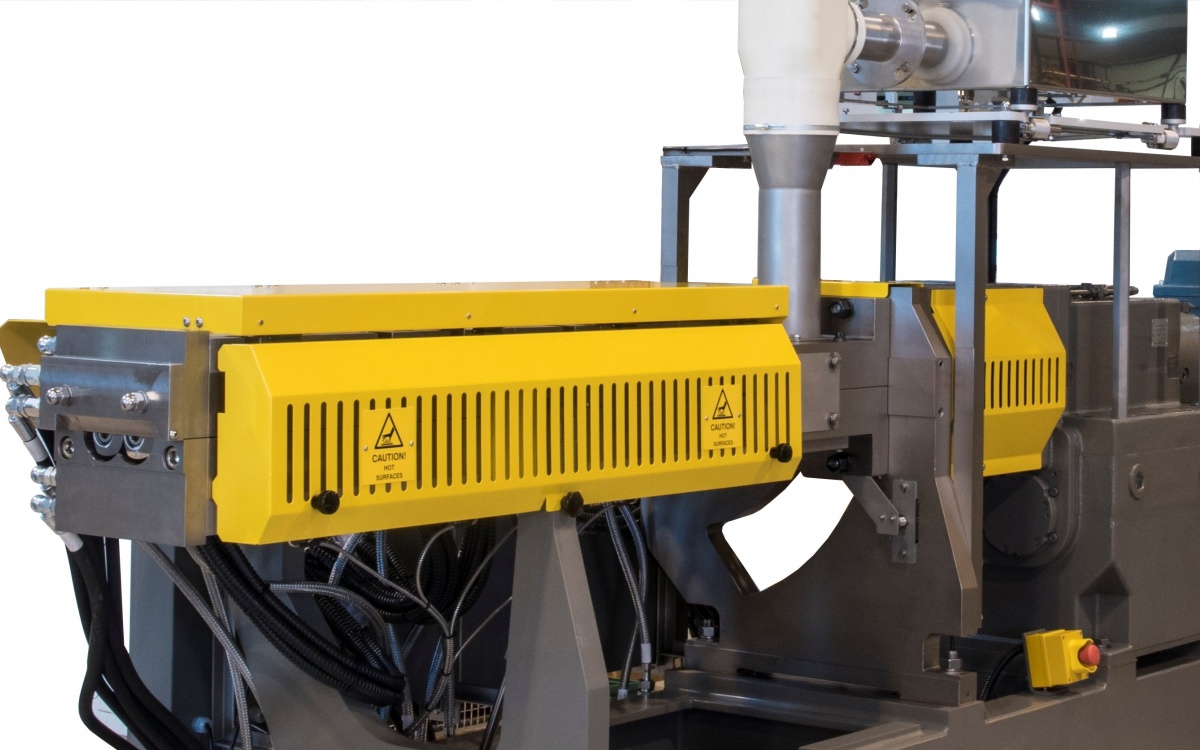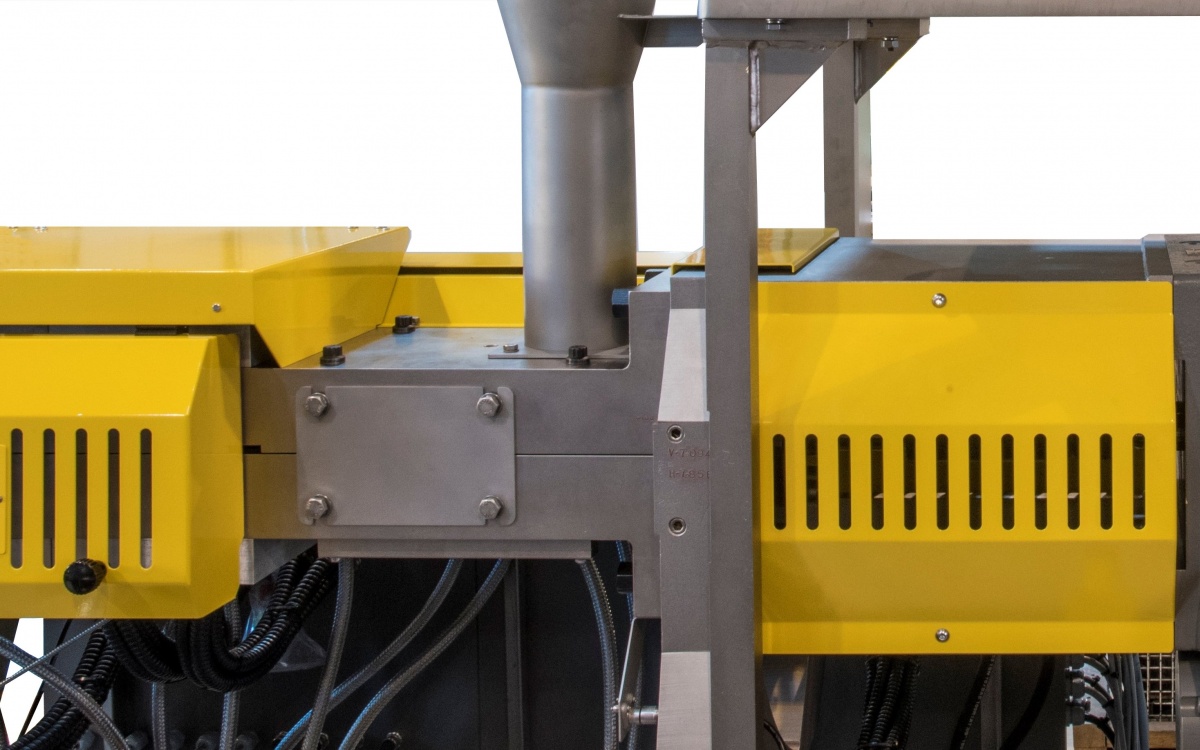News - NEA POWDER COATING NEWS
Baker Perkins MAX3 feed system
The innovative Baker Perkins MAX³ feed system for twin-screw powder coating extruders solves a long-term problem within the industry of restricted output and torque surges caused by material building up in the extruder feed port. The introduction of MAX³ has led to impressive production increases at installations throughout the world, over all formulations.
The patented MAX³ system features a re-designed feed port and screws to improve flow of material into the extruder barrel and air out of it. Material build up occurs when particles hit the intake screws and ‘bounce’ back into the infeed areas, rather than flowing into the machine.
As the material trapped in the infeed area builds up, it becomes progressively more difficult for ait to escape, which reduces even further the flow of material into the extruder barrel. The torque load increases until either the blockage clears and the cycle repeats, or the machine cuts out.
The most common way of dealing with the problem was to reduce the feed rate of material into the extruder, inevitably leading to lower output. With MAX³ the extruder is still ‘starve fed’, but at a higher rate.
Efficient material handling
A major benefit is that lightweight, low-density materials are handled much more efficiently, eliminating the need for side feeding. Side feeders have been a useful alternative to conventional top feeding in the powder coating industry. They were developed 20 years ago, and served a purpose for some applications – especially where lightweight materials or/and a high percentage of fines was involved.
With the development of the MAX³ feeding system, they have had their day. There are some serious drawbacks to side feeding. Extra floor space is needed; cost of ownership is higher, with increased capital and operating expenditure; the operator’s job is more awkward with access difficulties; and cleaning takes much longer.
Side feeders force product into the screws, causing high levels of wear. They create heat which can affect quality by pre-curing; pre-melt of resin on the screws causes loss of conveying capacity. Changing parameters for a new product takes time, increasing turnaround between runs.

Some very specialist operations may still justify side feeding, but these situations are rare. The MAX³ top feeding system has proven versatility to handle a broad range of materials including lightweight low-density recipes with high levels of fines.
Throughput improvements
In production at customers’ plants, the MAX³ consistently leads to a throughput increase of up to 40%. Some results have been spectacular.
In Korea, installing a MAX³ system and upgrading the screw configuration on an 80mm MP twin-screw extruder raised output almost 300%, from 525 to 1500 kg/hour. The product is an epoxy coating for underground pipes – a heavy duty functional coating that is notoriously difficult to process.
In Italy, trials with the MAX³ feed system on an extruder installed in 1999 eliminated 30% torque surges and raised throughput from 800 to 1560 kg/hour.

These trials involved an MP80 extruder using a black epoxy formulation with 40% low density filler. This had proved difficult to extrude due to torque fluctuations caused by the low density, and is a problem the MAX³ feed system was specifically designed to resolve.
At this installation MAX³ twin lead screws were fitted to replace conventional Alpha/Beta screws to reduce feed material ‘bounce’ and allow the lower bulk density fillers to fall into the screw flights.
The torque fluctuation disappeared and the feed rate was increased to over 1600kg/hour, although capacity restrictions on the downstream equipment meant that 1560 kg/hour was the optimum rate.
In the USA trials with two 65mm machines saw output rise by 275%. The test machine was a new MPX65, fitted with a MAX³ feed port and screw configuration. The other is an original MP65 with the same power and speed but without MAX³ or additional cooling development.
The result - 1,200 kg/hour on the new extruder versus 435 kg/hour on the previous model - was an exceptional increase. These trials involved exactly the same formulation to ensure a true comparison.
Also in the USA, a MP65 600rpm extruder that was only able to achieve 34% torque due to issues feeding a low bulk density black epoxy was fitted with new MAX³ twin lead feed screws, and was able to increase the torque to 56%. This resulted in throughput going up from 308 kg/hr to 517 kg/hr - a 67% increase. The customer is now using these feed screws on all their lines.
In the UK, a customer running a semi-gloss polyester had torque instability, fluctuating between 45% and 58%. Product was also bridging and backing up the feeder funnel. When new MAX³ lead screws were fitted, the torque stabilized at 48%. Throughput increased by 9% to 1,157kg/hour, and labour costs were reduced because a dedicated operator was no longer needed to watch over the torque fluctuations.

Baker Perkins capability to optimise productivity and quality in powder coating plants is based both on expertise gained in the field, and by trials in the Innovation Centre at Peterborough. These have included the successful transfer of production from single-screw and competitors’ twin-screw machines to Baker Perkins extruders.
The MAX³ is available with Baker Perkins’ MPX30, 40, 50, 65 and 80 barrel diameter extruders and also the MPX24 Integra laboratory and small batch machine. It can be retrofitted to existing machines.
Contact Baker Perkins:
Barry Dean
Sales Manager
Barry.Dean_at_bakerperkins.com
www.bakerperkins.com

Christian Begass
Product Specialist Powder Coating
+49-2451-481-203
christian.begass_at_neuman-esser.de
NEUMAN & ESSER Process Technology
Werkstr. o. Nr., 52531 Übach-Palenberg
